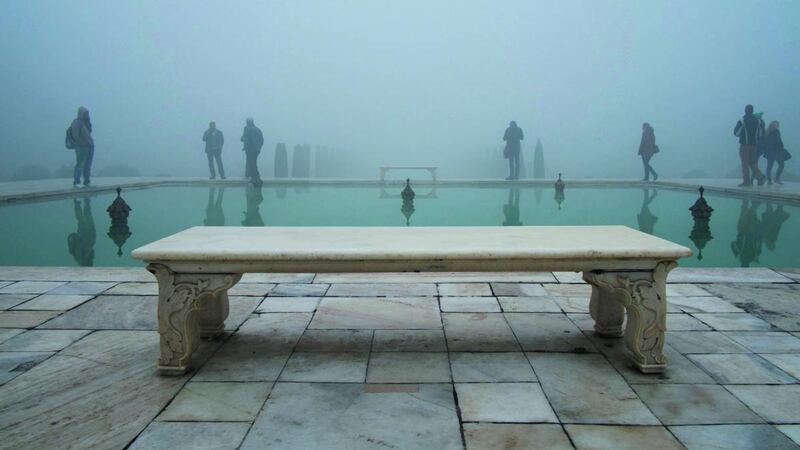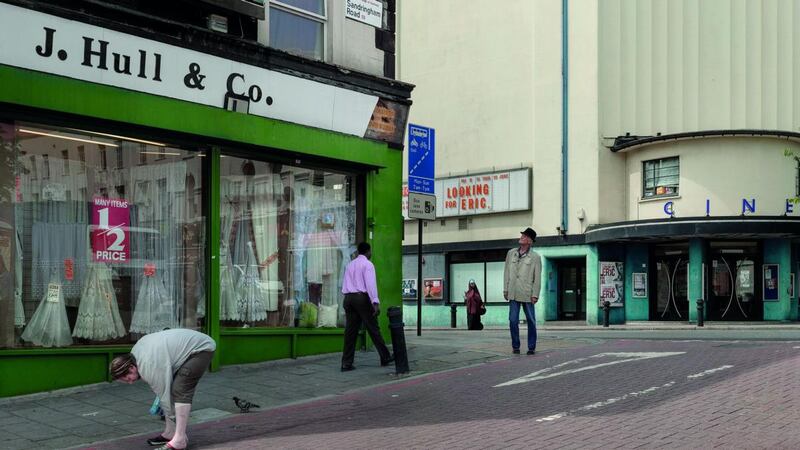Geoff Dyer is telling me about his Covid-19 vaccination. “About two or three weeks ago, suddenly the whole vaccine thing exploded, and I was inundated. It was like when I used to get invited to literary festivals – suddenly I was inundated with invitations to have a vaccine!”
Dyer has just published his third photography book, See/Saw: Looking at Photographs (after The Ongoing Moment and The Street Philosophy of Garry Winogrand). Reading this book is, simply put, a pleasurable experience, recalling Wilde’s image of the critic as artist. In writing criticism, I ask, is it important for him to achieve an aesthetic quality?
“Oh, absolutely. I don’t know, I suspect you possibly have a higher tolerance for academic writing than I do. I find that there’s so much stuff I can’t read now. So it’s important for me as a reader that I get that pleasure. And for me as a writer, actually making it fun is part of the fun of doing it.”
Where The Ongoing Moment’s focus was on the main figures in photography, See/Saw opens things out. The main section moves chronologically from Eugène Atget to Chloe Dewe Mathews, with one essay on each photographer, originally published in places like the New York Times Magazine’s On Photography column. The second section features 10 essays from Dyer’s Exposure column in the New Republic on photos from the news. The final section contains essays on Dyer’s critic forebears like Barthes and Berger. “I was happy with it being not just a random hamper of everything I’ve done in the last 10 years,” he says, “but being quite comprehensive, with a sort of narrative arc to it.

“For me, The Ongoing Moment had a very straight take on the canon precisely because I hadn’t done a history of photography at university or whatever. Hence, I was dealing with all the equivalents of Dickens in the realm of photography. Then all the stuff I was writing subsequently either filled in the gaps, or, of course, brings it much more up to date.
‘Condition of inclusion’
“So the motives for the pieces originally being written were a mixture. Then the only condition of inclusion, as it were, is that I felt that the piece had to be interesting, even if you hadn’t heard of whoever it was. And I’m guessing there are plenty of people in there whose names are only familiar, really, to people who are devotees of photography.”
My prior knowledge of photography isn’t vast, and I drank See/Saw up. I learned about Bevan Davies’s realist-cum-surrealist Los Angeles street photos (“Davies’s pictures extend the photographic moment so that we see time as experienced by the buildings in them.”) I learned about Luigi Ghirri’s dream-like images of mirrors and the Italian landscape (“the mystery is fathomless because it is quite transparent”). I learned about Nicholas Nixon’s study of the human condition through taking one photograph every year since 1975 of the same group of sisters (“The only way you can see the future is to wait for it to come around and record the results so that, in retrospect, it appears obvious and irrefutable. Meanwhile, we live the years. Or, more accurately, the years live us.”) Alongside analysis, we get wit, bons mots and maxims aplenty.
Given his profile as one of the world’s main writers on photography and the anthology aspect of a book like See/Saw, was Dyer conscious of his role in canon formation?
“You’re so nice, Liam, I can see you’re tempting me into a self-aggrandising [statement], to declare my great power! I wouldn’t put it in quite such Leavisean terms as you do.”
As an example, he mentions how he “just randomly came across those Peter Mitchell pictures of scarecrows, which I liked. Then I learned a bit more about Peter Mitchell, and it turns out he was a really important but overlooked figure in British photography and getting on a bit. For somebody like him to have a piece like that published in the New York Times Magazine really made a huge difference. So in a small way, people got to hear of his work who wouldn’t have done.
‘Rediscovery and rehabilitation’
“I guess the larger, less egotistical point is that it’s quite volatile, the photography scene [compared to] the canon in literature. On the one hand, [the literary canon] is really open to questioning. There’s all sorts of people where you’re thinking, ‘God, what on earth are they doing in there? Their books are actually rubbish!’ But it’s pretty impervious to that questioning and there’s all sorts of reasons why that’s going on. Whereas the history of photography is always having to get written. And Vivian Maier, who you rightly mentioned, is the most spectacular rediscovery and rehabilitation.”

Another rediscovered photographer Dyer analyses is Fred Herzog, who was doing artistic colour photography before colour photography was elevated into acceptable art. “If you were to do a history of colour photography, it’s a bit like doing a Miles Davis discography: you really want to do it on the internet, not in a book, because you’re going to have to keep issuing new revisions. It’s very open to its history being constantly updated and rewritten in photography. And of course that’s a great thing.”
My reading experience with See/Saw was to look at a photo like Herzog’s 1968 Man with a Bandage, then to read Dyer’s analysis of it, then to look at the photo again, seeing much more second time round. I ask about Dyer’s method. In regard to DiCorcia, Dyer mentions not wanting “to explain away the magic”. In writing about photos, how does he square this circle – rendering lucid without explaining away the magic?
“I don’t want to sound boastful, but maybe I got the hang of that pretty early, or it came naturally to me because of the huge importance to me of John Berger. If you think of what he writes about that Kertesz picture, A Red Hussar Leaving, what Berger does again and again is that he doesn’t impose some way of seeing on it. He has this wonderful ability to encourage the picture to speak for itself, to sort of verbalise what the picture is seeing.
‘Narrative power’
“I’ve always been keen to use the pictures [that are] telling some kind of story. But also, that would be linking up with your other point: it’s a question of trying to develop an argument which has some sort of narrative power as well. So you’re actually wondering, not what’s going to happen next, which is the basis of storytelling, but you know, ‘This is an interesting argument – I wonder where it’s going to go?”’

A short essay on Finbar O’Reilly’s photo of a distraught Palestinian man holding his injured daughter addresses how we view photos from this conflict. Dyer’s thought process leads to a remarkable question: “Could it be that, in spite of everything – in a situation that seems hopeless, when Palestinians are dependent on the political intervention of others – we are left looking to them, to the powerless, for hope?”
In short story writing, an often trotted-out idea is that of the epiphany: that a short narrative should hinge on a realisation experienced by the main character (a classic example is Gabriel’s realisation at the end of The Dead). I ask Dyer, extending the narrativity idea, whether when he writes about a photo he’s searching to find a moment of epiphany. He’s wary of being so reductive.
“I think I’m open-minded about it. Certain pictures strike me and then I think, why is this working on me so powerfully? Quite often in these pieces, I’ll take people through the process of reasoning or association that leads me from looking at it inquiringly to coming to some kind of conclusion. Again, although the tone is very different, that’s something I got from Berger.”
Dyer grew up in Gloucestershire and his home wasn’t abundant in photos. “Without ever wanting to make it sound like a tale of hardship, photography wasn’t a presence in our house. For the same reason everything wasn’t a presence in our house, mainly because of my dad’s phenomenal tightness! Which is so old[-fashioned], because now you can take 1,000 pictures in a couple of minutes.’
‘Swimming in vaccine’
These days Dyer lives in Los Angeles with his art curator wife Rebecca. As we near the end of our interview, I bring up the B word. “Obviously it’s quite interesting. There’s two things going on. On the one hand, the folly of Brexit is becoming daily more apparent. On the other hand, we’ve now got this rather triumphalist replay of the Battle of Britain whereby once again we’re standing alone, and you know, isn’t it great that we left the EU because they can’t vaccinate anybody and we’re just swimming in vaccine! So there’s those two things going on. But anyway, it’s so evident that Brexit is just terrible.”

Nonetheless, Dyer appreciates artists whose work engages positively with Englishness. He specifically mentions Martin Parr. “He’s doing a lot for British photography, as a historian, as a curator, as a practitioner.”
Dyer was a pioneer in writing books that blur genres – novels that read like essays and vice-versa. In closing, I ask whether it’s gratifying to see his influence on the many younger writers these days (not least in Ireland) following his example. His reply is characteristically modest.
“I’m pleased about it, yeah. I mean, it’s a nice change from when I was first doing it, when it was of no interest to anybody. The fact that [a book] was neither one thing nor the other became not something to be celebrated, but offered a multitude of yardsticks by which it failed to make the grade. It didn’t quite do it as fiction but it didn’t do it as non-fiction. So it’s nice that the judging apparatus has changed. Yeah, very pleased to be an influence on young Rob Doyle. As long as it doesn’t get to the point where, you know, I’m completely forgotten about, and it’s all just him! A situation I know he’s all the time lobbying for.”
See/Saw: Looking at Photographs is published by Canongate Books
















